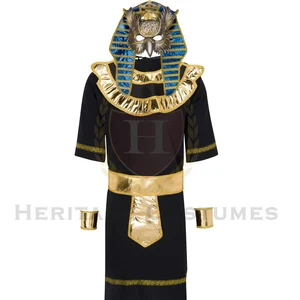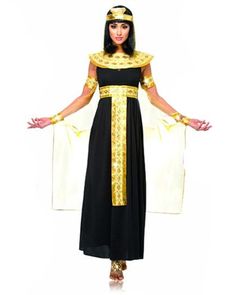
Egyptian Costume: 5 Fascinating Facts You Need to Know
Egyptian Costume: A Journey Through Time and Style
Egyptian culture is known for its rich history and iconic symbols that have influenced art, architecture, and fashion around the world. Among the many fascinating aspects of ancient Egypt, the traditional Egyptian costume stands out as a vivid expression of the country’s ancient civilization.
These garments were not only designed for style but also had practical, social, and religious significance.
In this blog, we’ll explore the evolution of Egyptian costume, from the ancient styles to the modern interpretations that honor the country’s cultural legacy.
Whether you’re a history buff or just curious about fashion, this journey through Egypt’s dress codes is a colorful and inspiring ride.
Ancient Egyptian Costume: A Symbol of Power and Spirituality
Ancient Egypt was a society deeply connected to its gods, the Nile, and the desert landscape. These influences shaped every aspect of life, including what people wore. Clothing was a way to express power, spirituality, and one’s place in the social hierarchy.
Materials and Fabrics
The hot climate of Egypt played a significant role in the choice of materials for clothing. Linen was the fabric of choice, favored for its lightness and ability to keep the body cool in the heat. Linen was derived from the flax plant, which grew abundantly in the fertile Nile Valley.
The finer the linen, the wealthier and higher-ranked the wearer.
The elite and the royals often wore almost transparent linen, signifying both their wealth and status. On the other hand, everyday Egyptians wore thicker, coarser linen, which was durable and practical for laborers and farmers.
Men’s Clothing
Men in ancient Egypt typically wore a simple linen wraparound skirt called a shendyt. This garment was usually tied at the waist with a belt and could vary in length, from knee-length to ankle-length, depending on the individual’s status.
The higher a man’s rank, the more elaborate and decorated his shendyt would be. Kings and nobles often adorned their skirts with pleats and fine details.
Pharaohs and gods were sometimes depicted wearing more elaborate robes, including kilts and tunics decorated with symbols of power such as the uraeus (cobra symbol) or falcons representing the god Horus. These garments indicated the wearer’s divine right to rule.
Women’s Clothing
Women’s costumes in ancient Egypt were elegant yet simple. The most common garment for women was the kalasiris, a full-length dress that could either be fitted or loose, depending on fashion trends and social status.
Wealthy women often wore the kalasiris with pleats and draped it with decorative jewelry, such as collars made of precious stones, beads, and gold.
Elite women, including queens, sometimes wore garments with intricate beading and embroidery, displaying their high status. Their clothing also emphasized modesty and grace, reflecting the cultural values of the time.
Accessories and Jewelry
Both men and women in ancient Egypt wore accessories and jewelry that were more than just decorative. These pieces were often believed to have protective qualities or be symbols of wealth and divine power. The wesekh, a wide,
heavy collar made of beads or gold, was a popular accessory among the elite, often paired with bracelets, anklets, and rings.
Pharaohs and gods were depicted wearing headdresses such as the nemes (a striped headcloth) or crowns that signified their rule and connection to the gods. Symbolic ornaments like the ankh (symbol of life) were also common, worn as amulets to ward off evil.
The Evolution of Egyptian Costume in Later Periods
 As Egypt came under the influence of foreign empires like the Greeks and Romans, traditional costumes began to evolve. While linen remained the dominant fabric, new influences started to appear in fashion, such as the use of wool and more elaborate draping styles.
As Egypt came under the influence of foreign empires like the Greeks and Romans, traditional costumes began to evolve. While linen remained the dominant fabric, new influences started to appear in fashion, such as the use of wool and more elaborate draping styles.
During the Greco-Roman period, Egyptian clothing became more diverse. Roman-style togas, robes, and tunics mixed with traditional Egyptian garments, creating a blend of cultures. These influences also impacted hairstyles, as wigs and elaborate headdresses became more popular among both men and women.
The importance of jewelry and amulets continued, with the Egyptian elite still wearing gold and gemstones, often incorporating motifs of ancient deities into their designs. Some of these elements persist in modern interpretations of Egyptian costume.
Modern Interpretations of Egyptian Costume
Today, Egyptian costume is often seen in festivals, films, and fashion shows that celebrate the country’s rich history. Modern designers have found inspiration in the ancient styles, incorporating traditional Egyptian elements like pleats, collars, and beadwork into contemporary fashion.
During special events like the annual Pharaonic Marathon or historical reenactments, participants often dress in Egyptian-style garments, paying tribute to the grandeur of ancient Egypt. Costumes for these occasions frequently draw from the traditional silhouettes of the shendyt, kalasiris,
and the iconic royal garments worn by pharaohs.
Costumes in Popular Culture
The image of the ancient Egyptian has been immortalized in popular culture, particularly in movies, TV shows, and Halloween costumes. Cleopatra’s iconic look, for example, with her sleek black wig, headdress, and gold jewelry, is one of the most famous representations of Egyptian fashion.
Designers and costume makers for these productions usually blend historical accuracy with creative liberties, giving audiences a glimpse into what the ancient Egyptians may have looked like, while adding a modern flair. This has led to an enduring fascination with Egyptian costume in
the fashion and entertainment industries.
The Lasting Legacy of Egyptian CostumeThe costumes of ancient Egypt continue to fascinate people around the world, from historians to fashion enthusiasts. The attention to detail, use of fine materials, and symbolic elements in their attire tell a story of a civilization that valued beauty, spirituality, and social order.
Even today, the influence of Egyptian fashion can be seen in runway collections, jewelry designs, and costume recreations. Whether in art or everyday wear, elements of ancient Egyptian style continue to inspire, proving that the legacy of this civilization is as timeless as the pyramids.
Conclusion
Egyptian costume is more than just clothing; it’s a window into the past. Through their garments, the ancient Egyptians expressed their values, beliefs, and social structures. From the simple linen shendyt worn by laborers to the intricate, symbolic attire of the pharaohs,
Egyptian costume tells the story of a vibrant and complex society.
As we admire the beauty and craftsmanship of these ancient clothes, we also gain a deeper understanding of the people who wore them and the world they lived in. Whether in its original form or reimagined in modern fashion, the influence of Egyptian costume remains strong today, a testament to its enduring appeal.
